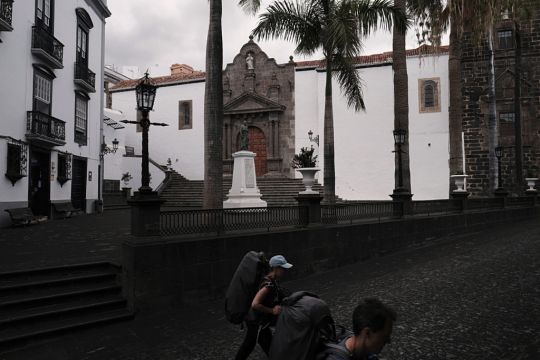A volcano on a Spanish island that has buried more than 500 buildings and displaced more than 6,000 people since it erupted last week has stopped releasing large clouds of ash and molten rock into the air.
But scientists say it is too early to declare the eruption phase finished.
Live footage from Canary Islands Television showed the Cumbre Vieja range on the island of La Palma without the plume of ash that has been emerging from the main vent that opened on September 19.

“The volcano of La Palma has entered in a phase of lower activity,” the Madrid-based Institute of Geosciences (IGEO) said in a tweet.
“Let’s see how it evolves in the coming hours.”
The archipelago’s volcanology institute, Involcan, published graphs showing a sharp decline in seismic activity in the area.
“In the last hours, the volcanic tremor has almost disappeared, as well as the strombolian explosive activity,” Involcan said on Twitter.

But experts were on alert as the swarm of quakes that preceded and accompanied Spain’s first volcanic eruption on land in half-a-century moved south, with more activity detected in the island’s Fuencaliente area, Spain’s National Geographic Institute said.
“That the volcano is now less active doesn’t mean that it cannot change,” the institute’s top investigator, Stavros Meletlidis, told broadcaster Antena 3.
Meanwhile, authorities in Spain’s La Palma island advised residents in four neighbourhoods to remain indoors to avoid toxic gases that could be released as a result of lava at more than 1,000C (1,830F) meeting Atlantic Ocean water at a temperature of around 20C (68F).
Scientists said the thermal shock resulted in the release of water vapour plumes loaded with hydrochloric acid and tiny particles of volcanic glass that could cause skin, eye and respiratory tract irritation.

Residents in San Borondon, Marina Alta, Marina Baja and La Condesa were told not to venture out and to keep doors and windows closed.
The speed of the flow had increased since Sunday as a result of more fluid lava descending down a sharp slope towards cliffs onto the sea.
The flow was some 800 metres (half-a-mile) from reaching the water early on Monday, the authorities said.
More than 230 hectares have been buried by the lava, which has destroyed more than 11 miles (18km) of roads, according to Copernicus, the EU’s satellite monitoring service.

The molten rock has destroyed houses, schools, churches and health centres, as well as irrigation infrastructure for the island’s banana plantations, which provide nearly one-third of the island’s jobs.
No fatalities or serious injuries have been reported since the volcano’s eruption.
La Palma, home to about 85,000 people, is part of the volcanic Canary Islands, an archipelago off northwest Africa.
The island is roughly 22 miles (35km) long and 12 miles (20km) wide at its broadest point.







